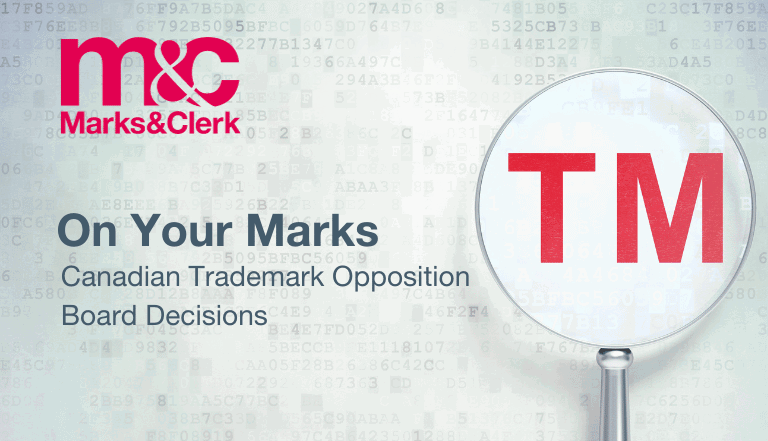In Garmin Switzerland GmbH and Vivo Mobile Communications Ltd., 2023 TMOB 172, the Trademarks Opposition Board refused registration of the mark VIVO owing to the applicant’s failure to demonstrate on a balance of probabilities that there was no reasonable likelihood of confusion with the following registered trademarks: TMA909,532 (VIVOFIT), and TMA899,032 (VIVOSMART), and TMA1,081,876 (VIVOSPORT).
Garmin Switzerland GmbH (the Opponent) opposed registration of the trademark VIVO (the Mark), the subject of two applications (Nos. 1,863,258 and 1,861,990; and collectively, the Applications), filed by Vivo Mobile Communication Ltd. (the Applicant).
The Applications for the Mark were filed based upon proposed use in association with telecommunications products and services and the opposition to the Mark was primarily based on an allegation of confusion with one or more of the Opponent’s VIVO-formative trademarks.
The Opponent established that the striking or dominant element of its relied-upon trademarks is the component VIVO and that this element is not descriptive or suggestive of the associated goods. The inherent distinctiveness of the Opponent’s marks was determined to be lessened by the suffix components FIT, SMART, and SPORT, considered to be suggestive/descriptive of products that relate to fitness, smart technology, and sport. The Applicant’s Mark, on the other hand, was considered to possess a higher degree of inherent distinctiveness, as it is comprised of only the term VIVO, which has no particular connotation with respect of the associated goods or services.
While the Applicant provided information relating to the Applicant’s global presence, no evidence of use, advertising or promotion of the Applicant’s Mark in Canada was submitted, and the Applicant was unable to establish the extent to which the Applicant’s Mark had become known in Canada.
The Opponent’s evidence was considered to show extensive use of its registered VIVO trademarks in Canada since 2014 (and 2017 in the case of VIVOSPORT) and established that its VIVO-formative registered trademarks have become known to some extent in Canada.
Overall, while the inherent distinctiveness factors for assessing confusion were considered to slightly favour the Applicant, the acquired distinctiveness and length of time in use factors were considered to favour the Opponent.
With respect to the assessment of the nature of the goods, the Board considered the Applicant’s goods, which encompass computers, computer related components and accessories, including accessories for telecommunication devices such as smartphones, including the GPS-related goods and the Applicant’s services, which are related to the advertising, promotion and sale of related goods, and concluded that the services, described as being in the field of “mobile phones, mobile phone accessories, computers, computer software, computer peripherals and consumer electronics”, are closely related to the field in which the Opponent operates – consumer electronic products.
The Applicant’s evidence attested to the fact that, in other countries, its goods are offered through specialized channels of trade, namely through its official website, and authorized VIVO retail stores that sell only VIVO smartphones, with the same channels of trade being intended in Canada. The Board rejected the Applicant’s additional arguments that smartphone consumers carefully research competing technologies before purchasing a smartphone and that consumers would also take care in purchasing the Opponent’s products.
The Opponent submitted that, while its goods are not mobile phones or smart phones themselves, they are personal electronic devices (such as wearable activity trackers and smart watches) that are nonetheless intended to be used and integrated with a user’s smartphone or other mobile device. As such, the Board concluded that there is a similarly strong connection between the Applicant’s goods (and services related to such goods) and the Opponent’s registered goods.
As there were no such restrictions to channels of trade in the Applications for the Mark, and likewise no restrictions in the Opponent’s registrations as to channels of trade, the Board concluded that the focus must be on the terms set out in the Application for the Mark and on what “the registration would authorize the [Applicant] to do, not what the [Applicant] happens to be doing at the moment.”
With respect to the assessment of the degree of resemblance between the marks, the Board concluded that the second component of the Opponent’s marks “do not meaningfully diminish the resemblance between the Mark and the Opponent’s trademarks in appearance and sound” and the Applicant’s Mark shares a high degree of resemblance, given that it is identical to the dominant and striking element of the Opponent’s relied upon marks. The Board additionally noted that the dominant portion of the Opponent’s marks, VIVO, was adopted as the Mark in its entirety.
In terms of surrounding circumstances, the Opponent submitted that its marks comprised a family of VIVO marks as a circumstance that increases the likelihood of confusion in this case and the Board agreed.



